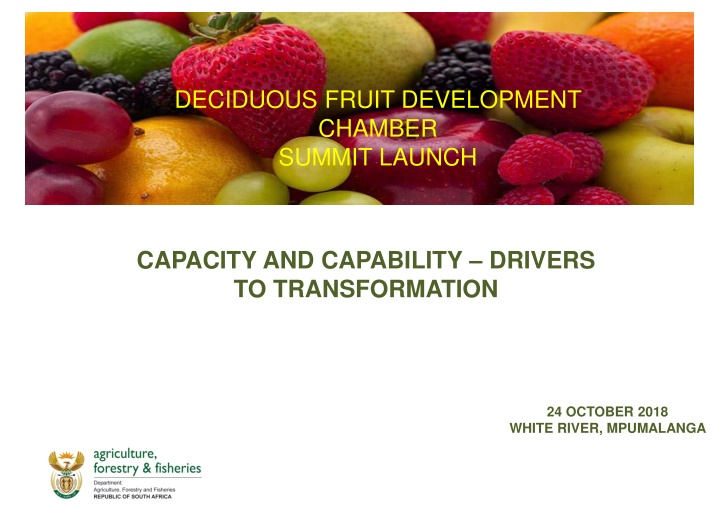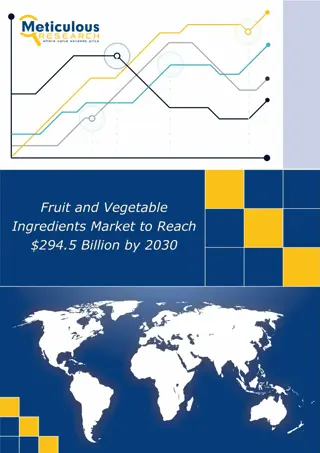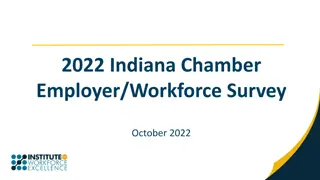
Enhancing Agricultural Capacity and Capability Through Training and Development
Explore the journey towards improving agricultural capacity and capability in South Africa, focusing on national development targets, current challenges in the education and training system, and the need for innovative interventions. Discover how efforts are being made to bridge the gap between capacity and capability in the agricultural sector.
Download Presentation

Please find below an Image/Link to download the presentation.
The content on the website is provided AS IS for your information and personal use only. It may not be sold, licensed, or shared on other websites without obtaining consent from the author. If you encounter any issues during the download, it is possible that the publisher has removed the file from their server.
You are allowed to download the files provided on this website for personal or commercial use, subject to the condition that they are used lawfully. All files are the property of their respective owners.
The content on the website is provided AS IS for your information and personal use only. It may not be sold, licensed, or shared on other websites without obtaining consent from the author.
E N D
Presentation Transcript
DECIDUOUS FRUIT DEVELOPMENT CHAMBER SUMMIT LAUNCH CAPACITY AND CAPABILITY DRIVERS TO TRANSFORMATION 24 OCTOBER 2018 WHITE RIVER, MPUMALANGA
OUTLINE Context Current landscape Capacity vrs capability Capacity development road map Ideal interventions Conclusion 2
NATIONAL DEVELOPMENT TARGETS RELATING TO CAPACITY BUILDING IN AGRICULTURE National Development Plan (NDP) agenda for Agricultural Education and Training for the next 12yrs (NPC, 2011) : The creation of an additional 1 million jobs in the agriculture, agro-processing and related sectors Increased investment in agricultural technologies, research and the development of adaptation strategies Expanding the colleges system with a focus on improving quality Improved skills development and training including entrepreneurship training and a new cadre of extension officers Innovative means for agricultural extension and training by the state in partnership with industries 3
WHERE ARE WE? THE CURRENT AET SYSTEM IN SOUTH AFRICA Fragmentation and lack of coordination Poor and inconsistent quality control Poor access to AET by emerging farmers and new entrants into agriculture An ineffective and non- responsive system Agriculture s negative career image A shortage of critical skills 4
CURRENT EDUCATION AND TRAINING SYSTEM IN RSA cont The current education and training system is deficient in its reach and inclusion of significant sectors of the society: EMPLOYED AND SELF EMPLOYED WORKERS FARM WORKERS AND OTHER ELEMENTARY LEVEL LAND REFORM BENEFICIARIES WOMEN AND YOUTH o Despite formal training, they are trapped in low level occupations and have few opportunities to break away. Without marketable skills they are rendered marginalised and powerless o They are hidden in the economy and are absent from any strategic planning or occupational development o Women are still among the least educated and skilled members of the labour force. Unemployed gradates evidence of deficiency of the system o This is not a disadvantaged group. There is a need of consistent, timeous targeted training for them o 5
CAPACITY VRS CAPABILITY CAPABILITY individual Skills (Training) Access Resources Utilisation of Resources CAPACITY organisational systemic 6
CURRENT TRENDS MANIFESTING IN THE SECTOR There are critical areas of change where substantial strengthening of the current system is needed: A shift from production that is exclusively for home consumption to more diversified and technology supported and market oriented primary production 1 A shift from production and sale of raw products towards vertically integrating household livelihoods to capture value addition. 2 A growing demand for knowledge and skills needed to adapt to climate change and adoption of environmentally friendly production and processing 3 Movement towards greening in terms of producing green products such as bio fuels and bio plastic and green jobs 4 5 A trend towards the adoption of ICT in all areas 7
ROADMAP TOWARDS TRANSFORMATIVE CHANGE IN THE AET SYSTEM To fill needed roles in the sector with direct benefits for SHFs Supportive environment Right institutional mix Inadequate numbers to meet sector demand for Strategic priority for agric. & rural development Graduates with appropriate skill mix and levels Universities Researchers Researchers Increased agricultural productivity for SHFs and the agricultural sector as a whole Agricultural colleges Academic Staff PhD Academic Staff Sufficient & sustainable funding for AET institutions Policymakers & bureaucrats Other MSc Policymakers & bureaucrats With adequate resources BSc & indirect benefits for SHFs Managers & entrepreneurs Diploma/ Certificate Academic Staff Research & knowledge creation Secondary school supply Relevant curriculum Extension agents Facilities/ resources Policy analysis & development Academic Staff Teaching & Training With strong linkages to and feedback mechanism from Extension Workers Policymakers SHFs Agribusiness Researchers 8 Linked to and supported by regional and global institutions, networks and collaborations
INTERVENTIONS Mentorship Entrepreneurial Training Work Integrated Learning and placement of unemployed graduates within the sector Innovation Systems and inclusion of ICT systems Network Platforms Private sector involvement in governance and funding Curriculum development addressing mismatch labour demand and supply 9
CONCLUSION o EFFECTIVE GOVERNANCE OF AET SYSTEM: the system is governed in a collaborative manner to design, implement and evaluate relevant and accountable training programmes o GREATER REACH AND INCLUSION the system is structured to accommodate the needs and requirements of women and youth, those in elementary occupations, land reform beneficiaries and those working in the informal sector, and to create pathways for employment and advancement o UNITY OF THOUGHT AND COLLECTIVE ACTION all stakeholders share the same understanding of the concept and practical application of capacity building for transformation in the sector. This understanding is translated into collaborative collective that institutional boundaries traverses structural and 10
CONCLUSION o FINANCING SOURCES AND MECHANISMS the current single channel financing mechanisms need to be augmented with additional financing sources and mechanisms managed, monitored and evaluated collectively by both government and the industry 11






















